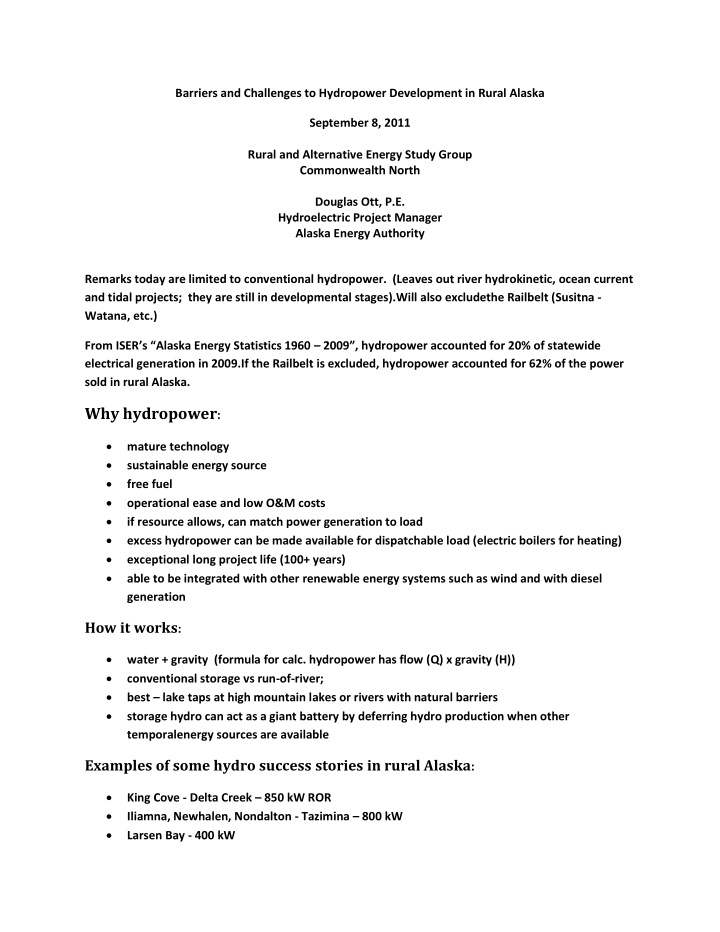



Barriers and Challenges to Hydropower Development in Rural Alaska September 8, 2011 Rural and Alternative Energy Study Group Commonwealth North Douglas Ott, P.E. Hydroelectric Project Manager Alaska Energy Authority Remarks today are limited to conventional hydropower. (Leaves out river hydrokinetic, ocean current and tidal projects; they are still in developmental stages).Will also excludethe Railbelt (Susitna - Watana, etc.) From ISER’s “Alaska Energy Statistics 1960 – 2009”, h ydropower accounted for 20% of statewide electrical generation in 2009.If the Railbelt is excluded, hydropower accounted for 62% of the power sold in rural Alaska. Why hydropower : mature technology sustainable energy source free fuel operational ease and low O&M costs if resource allows, can match power generation to load excess hydropower can be made available for dispatchable load (electric boilers for heating) exceptional long project life (100+ years) able to be integrated with other renewable energy systems such as wind and with diesel generation How it works : water + gravity (formula for calc. hydropower has flow (Q) x gravity (H)) conventional storage vs run-of-river; best – lake taps at high mountain lakes or rivers with natural barriers storage hydro can act as a giant battery by deferring hydro production when other temporalenergy sources are available Examples of some hydro success stories in rural Alaska : King Cove - Delta Creek – 850 kW ROR Iliamna, Newhalen, Nondalton - Tazimina – 800 kW Larsen Bay - 400 kW
Atka – Chuniisax Creek - 250 kW Ouzinkie – 100 kW Glacier Bay – Falls Creek – 800 kW Kodiak, Port Lions – Terror Lake – 30 MW (plus 4.5 MW wind on Pillar Mtn) Cordova – Humpback Creek and Power Creek – 1.25 / 6 MW Valdez/Glenallen - Solomon Gulch – 12 MW Some newly proposedin rural AK (Not in SE AK , but are they all feasible?) : Chitina – Five Mile Creek – 300 kW Old Harbor – Mountain Creek – 265 kW YK Region – Chikuminuk – 13 MW Chignik Lagoon – Packer Creek – 400 kW Angoon – Thayer Creek – 1.1 MW King Cove (2 nd hydro) – Waterfall Creek – 375 kW Copper Valley - Allison Creek – 6.5 MW; Deployment scenarios: short, mid-term and long term in Alaska Energy Pathway Hydro in long term time frame (6 – 12 years from studies to first power) CURRENT CHALLENGES: Regulatory: licensing costs time to license (3-5+ years) FERC or no FERC regulatory risks give uncertainty as to impacts on project cost and energy generation operational impactsfrom mandatory conditions from resource agencies in FERC process (fish habitat protection, protection of federal lands, fishway prescriptions, etc.) local and state permits in some locations hydro development can increase available fish habitat and populations site control Financing: large upfront capital costs where available bonds can be floated high costs in first years of operations best if spread over longer project life (+30 years) grants may be available to reduce borrowing costs (AEA has hydro-related grants at $53M + $57M match in RE Fund in Rds 1-4; 23 new applications in Round 5
low ROI Power Project Fund (low interest loans) Costs: tendency for estimated project budget to grow during design project budgets impacted by field changes during construction hydro construction costs today start at $7000/kW, can be higher for more remote communities cost overruns are possible Projects: seasonality of flows vs load icing conditions and frazil ice distance of hydro site to village load costs of transmission and road access integration of hydro project to back-up diesel generation (electronic controls) potential for transmission interconnections between villages to share hydro resources heating loads may use up capacity quickly Cost of energy: based on payments needed to make annual debt repayment, O&M costs and utility admin costs large storage hydros greater than 40 years fully paid off produce power at 1-2 cents/kWh recently constructed small hydro projects in the range of $0.25 - .35/kWh if construction costs are fully amortized, but less if grants are used to lower borrowed amts hydropower availability can vary as much as +/- 20% from the norm, depending upon the water year within a longer time frame, hydropower provides for rate stability that can last for 50 – 100 years Take aways: Hydropower will not solve the energy needs for most villages, however, those lucky enough to have a hydro resource nearby should make every effort to investigate it, license and develop it if it looks feasible. Hydropower gives a surety in power sales rates that lasts for generations. It can be integrated with other renewable resources such as wind and with backup diesel so that increased reliability can be achieved Hydropower is the most mature of the renewable energy technologies Hydropower projects take a long time to license (3 -5 years) and their infrastructure costs a lot to build
Recommend
More recommend